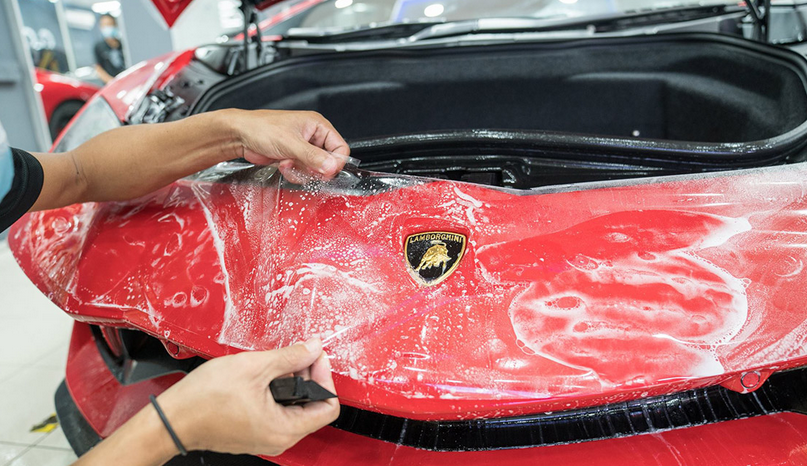Your vehicle’s paint is more than just a pretty surface. It’s a protective shield that prevents rust, corrosion, and other damage from reaching the body panels underneath. But in a world filled with flying road debris, unforgiving weather, and constant UV exposure, how do you keep your car’s finish looking pristine? The answer is car paint protection. This term covers a variety of methods and products—ranging from simple waxes to advanced films—all aimed at safeguarding your paintwork. In this post, we’ll take a deep dive into the significance of car paint protection, the different options available, and how to choose a method that best suits your driving lifestyle and budget.

1. Why Protect Your Car’s Paint?
You might see shiny cars on the road and think the owners simply take pride in a glossy exterior. While aesthetics are a major reason people invest in car paint protection, there’s more at stake than mere appearance. Here are a few critical reasons to shield your vehicle’s finish:
- Guarding Against Elements: Road salt, acid rain, bird droppings, and bug splatter all contain corrosive elements that can eat away at paint over time.
- Blocking UV Rays: Sunlight can cause paint to fade, peel, or develop that chalky look you sometimes see on older vehicles.
- Preventing Chips and Scratches: Everyday highway driving exposes your paint to kicked-up gravel and debris, which can lead to unsightly chips.
- Avoiding Rust: Once the protective layer of paint is compromised, metal panels may rust—and that can quickly escalate into far more costly repairs.
Keeping your paint intact is essential for the longevity of your vehicle and can mean the difference between a vibrant, well-maintained car and a dull, weathered one.
2. Common Types of Car Paint Protection
When it comes to car paint protection, you have a spectrum of options. Each type comes with unique advantages and a different price range. Let’s explore the most common methods.
Natural Waxes and Synthetic Sealants
- Carnauba Wax: Derived from the leaves of a Brazilian palm tree, carnauba wax is widely known for imparting a warm, deep shine. However, it typically wears off in a few weeks to a couple of months.
- Synthetic Sealants: Polymer-based formulas are more durable than natural waxes, lasting up to six months in many cases. They provide a glossy finish and form a slick layer that can repel water and dirt better than many organic waxes.
Pros: Easy to apply and remove, affordable, adds gloss.
Cons: Limited durability; requires reapplication multiple times per year.
Ceramic Coatings
Ceramic coatings use nanotechnology to bond with a car’s clear coat, creating a hardened surface capable of resisting light scratches, UV damage, and chemical stains. They are generally hydrophobic, meaning water beads up and slides off more easily, taking a good deal of dirt and grime with it.
Pros: Long-lasting (often 1–5 years), strong resistance to oxidation and stains, reduces maintenance efforts.
Cons: Higher upfront cost; requires careful, often professional, application to avoid streaking or high spots.
Protective Films
In recent years, protective films (sometimes referred to as clear bra or PPF) have become a favorite among car enthusiasts. These films feature high-grade polyurethane or polymer materials that physically absorb the impact of small rocks and debris. Some variants have self-healing properties, allowing minor scratches to dissipate under warmth.
Pros: Excellent protection from rock chips and scratches, can preserve paint almost flawlessly, can be partially or fully applied to the vehicle. Ultra long-lasting (often 10-15 years)
Cons: Premium cost; quality of installation is critical, requiring professional expertise for the best results.
3. Key Benefits of Car Paint Protection
Investing in car paint protection isn’t just about vanity. Below are the practical benefits you can expect.
Preventing Damage and Fading
When your car’s paint is left unprotected, it’s continually bombarded by microscopic threats such as UV rays, industrial fallout, and acidic contaminants. Over time, these threats cause oxidation, leading to dull and discolored paint. Protective coatings, whether ceramic or film, act as a barrier that buffers the paint from these harmful elements.
Maintaining Aesthetics
If you’ve ever spent a weekend polishing your car to perfection, you know how satisfying it is to see the paint glow. But that freshly polished look doesn’t last forever if the paint’s surface remains unprotected. Methods like waxing or applying a synthetic sealant can lock in that gloss and can make routine cleaning much faster. Likewise, advanced solutions like ceramic coatings or PPF can keep that just-detailed look for a significantly longer period.
Enhancing Resale Value
A car with scratched or oxidized paint often signals neglect to potential buyers, even if the engine runs flawlessly. By investing in car paint protection, you’re effectively safeguarding your car’s resale value. A well-maintained exterior can lead to higher offers or quicker sales when it’s time to switch to a new vehicle. In some cases, the difference in resale price can more than offset the costs of protective treatments.
4. How to Choose the Right Option
Deciding which form of car paint protection is best depends on several considerations:
- Budget: Waxes and sealants are typically the most affordable in the short term. Ceramic coatings and protective films come at a higher price point but can offer extensive, long-lasting coverage that may save money on repairs or reapplication over the years.
- Usage Habits: If you frequently drive on highways or in areas with lots of gravel, a stronger protective film might be worth the investment. If your car is mostly garaged, a ceramic coating could be sufficient for defending against occasional hazards.
- DIY vs. Professional: Waxing and applying synthetic sealants can be a fun weekend project, while ceramic coatings and films usually demand professional expertise. Hiring a certified installer helps ensure that the job is done correctly and that you enjoy the maximum benefits of your chosen protection method.
- Longevity: Think about how often you’re willing to reapply. Waxes may need refreshing every few months, whereas ceramic coatings and films can last for years with proper care.
5. Installation and Maintenance Tips
No matter which solution you choose for car paint protection, best practices and regular upkeep go a long way.
- Prep the Surface: Whether you’re applying wax yourself or scheduling a professional ceramic coat, make sure the paint is thoroughly cleaned and corrected. Contaminants or swirl marks trapped underneath can become more noticeable once sealed in.
- Follow Recommended Curing Times: Ceramic coatings and certain films have specific curing requirements. Keep the vehicle away from moisture and abrasive cleaning until the coating or film has set.
- Use Gentle Cleaning Methods: Avoid harsh detergents and automatic car washes with stiff brushes. Instead, opt for a pH-neutral soap, soft microfiber cloths, and gentle washing techniques.
- Inspect Edges and Seams (for films): Periodically check for any lifting or bubbles around the edges, which can happen if the film is exposed to high-pressure water jets or is not installed perfectly.
By following these guidelines, you’ll keep your chosen protective layer functioning effectively and looking great for as long as possible.
6. Frequently Asked Questions
Q: Does car paint protection eliminate the need for washing and detailing?
A: Not at all. While high-quality coatings and films can help repel dirt and stains, they don’t make your car maintenance-free. You’ll still need regular washes to remove built-up grime, although it often becomes easier and faster compared to an unprotected surface.
Q: Can I apply multiple types of protection?
A: Sometimes, yes. For instance, you can place a ceramic coating on top of a protective film for enhanced gloss and added hydrophobic properties. However, always check compatibility or consult a professional to ensure they work well together.
Q: Is professional installation really necessary?
A: For waxes and basic sealants, probably not. But ceramic coatings and paint protection films require meticulous surface preparation, experience in application, and special tools to achieve optimal results. A professional can save you from costly mistakes.
7. Conclusion
Car paint protection is a forward-thinking strategy that preserves both the look and the value of your vehicle. Whether you opt for a simple wax, a durable ceramic coating, or a high-tech protective film, the aim is the same: to shield your paint from the everyday hazards that can dull its shine and compromise its integrity. By investing a little time, money, and care now, you stand to save significantly on future cosmetic repairs—and keep your car looking showroom-ready for miles to come.
When you’re ready to explore the best paint protection options for your lifestyle, don’t hesitate to consult with professionals who can assess your driving habits, vehicle type, and budget. With the right setup, your car’s exterior can remain as vibrant as the day you drove it off the lot, turning heads and fueling admiration wherever the road takes you.
